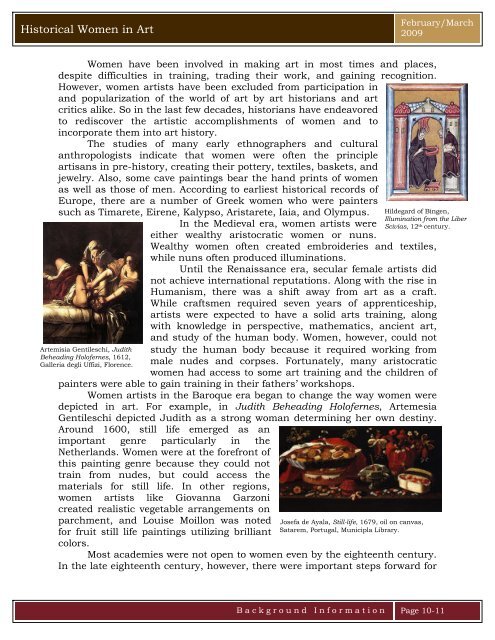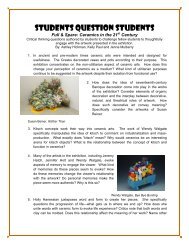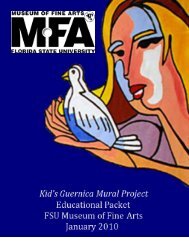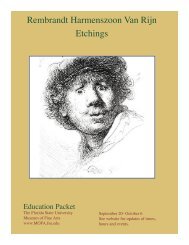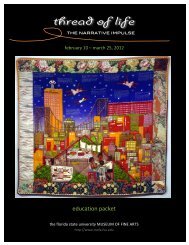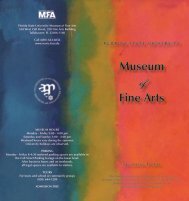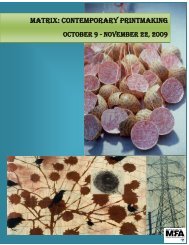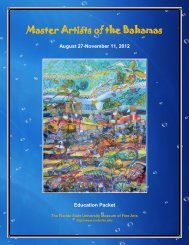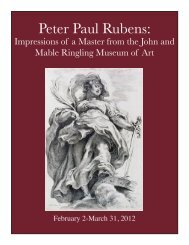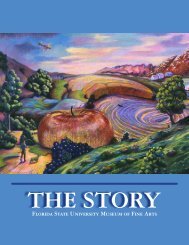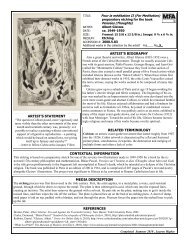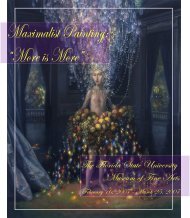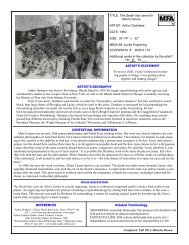old master drawings - Museum of Fine Arts - Florida State University
old master drawings - Museum of Fine Arts - Florida State University
old master drawings - Museum of Fine Arts - Florida State University
Create successful ePaper yourself
Turn your PDF publications into a flip-book with our unique Google optimized e-Paper software.
Historical Women in ArtFebruary/March2009Women have been involved in making art in most times and places,despite difficulties in training, trading their work, and gaining recognition.However, women artists have been excluded from participation inand popularization <strong>of</strong> the world <strong>of</strong> art by art historians and artcritics alike. So in the last few decades, historians have endeavoredto rediscover the artistic accomplishments <strong>of</strong> women and toincorporate them into art history.The studies <strong>of</strong> many early ethnographers and culturalanthropologists indicate that women were <strong>of</strong>ten the principleartisans in pre-history, creating their pottery, textiles, baskets, andjewelry. Also, some cave paintings bear the hand prints <strong>of</strong> womenas well as those <strong>of</strong> men. According to earliest historical records <strong>of</strong>Europe, there are a number <strong>of</strong> Greek women who were painterssuch as Timarete, Eirene, Kalypso, Aristarete, Iaia, and Olympus.In the Medieval era, women artists wereeither wealthy aristocratic women or nuns.Wealthy women <strong>of</strong>ten created embroideries and textiles,while nuns <strong>of</strong>ten produced illuminations.Artemisia Gentileschi, JudithBeheading Hol<strong>of</strong>ernes, 1612,Galleria degli Uffizi, Florence.Hildegard <strong>of</strong> Bingen,Illumination from the LiberScivias, 12 th century.Until the Renaissance era, secular female artists didnot achieve international reputations. Along with the rise inHumanism, there was a shift away from art as a craft.While craftsmen required seven years <strong>of</strong> apprenticeship,artists were expected to have a solid arts training, alongwith knowledge in perspective, mathematics, ancient art,and study <strong>of</strong> the human body. Women, however, could notstudy the human body because it required working frommale nudes and corpses. Fortunately, many aristocraticwomen had access to some art training and the children <strong>of</strong>painters were able to gain training in their fathers’ workshops.Women artists in the Baroque era began to change the way women weredepicted in art. For example, in Judith Beheading Hol<strong>of</strong>ernes, ArtemesiaGentileschi depicted Judith as a strong woman determining her own destiny.Around 1600, still life emerged as animportant genre particularly in theNetherlands. Women were at the forefront <strong>of</strong>this painting genre because they could nottrain from nudes, but could access thematerials for still life. In other regions,women artists like Giovanna Garzonicreated realistic vegetable arrangements onparchment, and Louise Moillon was notedfor fruit still life paintings utilizing brilliantcolors.Josefa de Ayala, Still-life, 1679, oil on canvas,Satarem, Portugal, Municipla Library.Most academies were not open to women even by the eighteenth century.In the late eighteenth century, however, there were important steps forward forBackground Information Page 10-11


